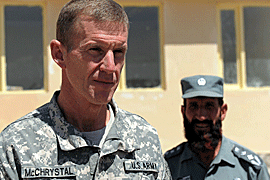Nato wary over Afghan commitment
Defence ministers back new counter-insurgency strategy but side-step issue of more troops.

“There were a number of allies who have indicated they were thinking about or moving toward increasing their military or their civilian contributions or both, and I found that very heartening.”
Legitimate government
A decision on troop reinforcements has been held up by concern over the fraud-tainted Afghan elections, because Nato allies want to be sure they will have a new government they can trust and work with.
Earlier on Friday, two Nato members said they would not send more soldiers to Afghanistan unless next month’s election creates a legitimate government.
Eimert Van Middelkoop, the Dutch defence minister, said his country is awaiting the final election results “because the legitimacy of the Afghan government is key”, as well as the decision on troop numbers by Obama.
Soeren Gade, Denmark’s defence minister, said allies will not increase troop levels until they are assured the new government in Kabul is committed to the Nato goals.
The US is considering sending as many as 40,000 troops, while Britain made a conditional offer of 500 soldiers prior to the talks in Slovakia.
McChrystal’s strategy puts protection of Afghan civilians at the centre of military action, forcing the fighters – bolstered from rear-bases across the border in Pakistan – to come to the military alliance and its partners.
Speaking following the meeting, Anders Fogh Rasmussen, the Nato secretary-general, said: “It does not solve the problems in Afghanistan just to hunt down and kill individual terrorists.
“What we need is a much broader strategy which stabilises the whole Afghan society.
“I have noted a broad support from all ministers on this counter-insurgency approach, but let me stress, without discussing the resource implications of these recommendations.”
Lack of trainers
Analysts argue for the Nato-led International Security Assistance Force (Isaf) to be able to leave, the Afghan army and police must be built up, with commanders recommending that number be more than doubled to 400,000 personnel.
 |
| McChrystal has requested more US troops to be deployed to Afghanistan [AFP] |
But Isaf is short of the thousands of trainers who would be needed to prepare what is basically the force’s exit strategy.
Gade said: “Hopefully we’ll agree to put more effort into the training area.
“We agree upon the fact that we need a stronger Afghan footprint all over Afghanistan, especially in the south and the east where there is heavy fighting.
“That is part of our exit strategy to make sure that the Afghan national army can deal with the security problem itself.”
Gates said that a US decision on troop numbers in Afghanistan was not far away.
He said: “Probably over the next two or three weeks we’re going to be considering some specific options and teeing them up for a decision by the president.”
There are currently about 65,000 US troops and 39,000 soldiers from allied nations in Afghanistan.
Mounting military and civilian casualties in Afghanistan have begun to eat away at popular support for the mission both there and in many alliance nations.